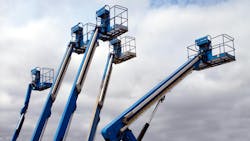Preventing Aerial Lift Accidents: A Guide for Electricians and Workers
Key Takeaways
- Ensure you have formal, hands-on training before operating an aerial lift; watching demonstrations is not sufficient.
- Inspect hydraulic hoses, controls, guardrails, and the platform's condition before each use to identify potential hazards.
- Operate the lift only when fully lowered with no passengers, and follow manufacturer instructions for safe operation.
About 25% of fatalities involving aerial lifts are electricians. From incident data, OSHA has identified the major modes of these fatalities and what to do to protect against them. Follow these 10 tips to prevent potentially deathly accidents.
- Operate a lift only if you have been trained in using it. If there’s not a formal process for this, it’s not real training. Watching while someone shows you up and down on a joystick is not training. Real training means you know such things as how to orient the lift relative to the work and how to stabilize the lift. Know and follow the manufacturer’s directions for loading, terrain, and other aspects of safely operating the lift.
- Scope out the job and where it will take place. Should you rope off the area? How much of it? Determine if you need people to serve as safety-watches. Is the aerial lift going to park on a grade? Then you need help with outrigging and blocking.
- Inspect the following before getting on the lift. Look for any hydraulic hoses, outriggers, controls (ensure they work as indicated), the condition of any gates/guardrails, and the condition of the working platform.
- Allow safety devices to do their job. If the lift won’t work because you can’t quite reach the foot pedal, the problem is not with the foot pedal. So don’t put a toolbox on it to “fix” the problem.
- Drive (or move the lift) only if it is in the fully lowered position with no passengers. Some lifts are designed to be moved at elevation, but there are specific limits to that, and these vary by model. The intent is not that you can drive around the plant at elevation, but that you can move a few feet at a time.
- Remember that driving on a grade is tricky. On the way down, drive at the lowest speed or gearing. Don’t stop midway when on the way up, keep your momentum so you don’t get stuck on the incline. If the incline is steep, it may be tempting to have some people push the lift from behind. This runs the risk of getting crushed by the lift. A safer way to do the assist is to use a come-along that is anchored to a suitable support. Choose a bollard over a building column, as damage to the first is far less expensive than damage to the second. A lift truck is also capable of assist-towing the aerial lift up an incline
- Don’t try to extract a dead lift up an incline. For one thing, the support may not withstand the pulling force. Instead, use a come-along to allow safely lowering the lift to the bottom. Once it’s down, push it out of the way and charge or replace the battery in this safe position. The exception is that a typical LP gas lift truck is capable of extracting (or pushing) a dead aerial lift up an incline. Don’t attempt this with an electric lift truck, unless it is rated for this load and has sufficient battery reserves for the task.
- Strap in so you don’t fall out. Additionally, stand on the platform not on any guardrails.
- Raise the lift only if you can see that the area above the lift is clear of obstructions, especially wires. A typical mistake is that of lifting people right into energized bus or other dangers. This is what you want to prevent by ensuring there are no obstacles.
- Once you are in the working position, re-evaluate your clearances in all directions. Evaluate whether the lift is close enough to the work. If you can reach it only by standing on a ladder on the lift platform, leaning over the guard rails, or standing on the guard rails, the lift is in the wrong position. Adjust accordingly.
About the Author

Mark Lamendola
Mark is an expert in maintenance management, having racked up an impressive track record during his time working in the field. He also has extensive knowledge of, and practical expertise with, the National Electrical Code (NEC). Through his consulting business, he provides articles and training materials on electrical topics, specializing in making difficult subjects easy to understand and focusing on the practical aspects of electrical work.
Prior to starting his own business, Mark served as the Technical Editor on EC&M for six years, worked three years in nuclear maintenance, six years as a contract project engineer/project manager, three years as a systems engineer, and three years in plant maintenance management.
Mark earned an AAS degree from Rock Valley College, a BSEET from Columbia Pacific University, and an MBA from Lake Erie College. He’s also completed several related certifications over the years and even was formerly licensed as a Master Electrician. He is a Senior Member of the IEEE and past Chairman of the Kansas City Chapters of both the IEEE and the IEEE Computer Society. Mark also served as the program director for, a board member of, and webmaster of, the Midwest Chapter of the 7x24 Exchange. He has also held memberships with the following organizations: NETA, NFPA, International Association of Webmasters, and Institute of Certified Professional Managers.
